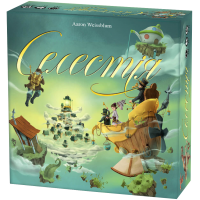Believe me! I can do it! Celestia game review
Related Products
DESCRIPTION OF THE CELESTIA BOARD GAME

In Aaron Weisblum's last game, a remake of 1999's Cloud 9, players board a skyship to collect treasure in various cities around the world of Celestia.
Celestia is a light dice game with a try-your-luck mechanic and features top-notch components. That's what drew me to Essen 2015, when the game topped many hot lists. And over the course of a few games, I began to admire the clever gameplay in addition to the beautiful components.
ABANDON SHIP OR TRY YOUR LUCK
Celestia is a card and dice game. Each player's goal is to discover and collect treasures in the most remote cities of the world of Celestia. The player who builds the most prestigious treasure collection (ie the player with the highest score when the player reaches 50 points) is the winner.
Each player chooses a color and their pawns are placed on the ship. The ship will move from cities with a low number to cities with a high number, and the longer the player stays on the ship, the better the reward. But if the ship doesn't survive the peril, any players unlucky enough to stay aboard get nothing!
One player is appointed captain; this role will change as the journey progresses. The captain cannot disembark while there are other passengers on board.

In a certain turn, the following will happen:
- The captain rolls the die. The number of dice rolled depends on the number of dice symbols in the next city on the ship's path.
- Each passenger chooses whether to continue the journey. Going around the table clockwise, each player announces whether he will stay on the ship or leave. If they leave, they take a "treasure" from the deck corresponding to the city they are currently in. A player always gets at least the number of points corresponding to the city, but he can get more. Treasures become more expensive the further along the ship goes, so the passengers try to stay on it as long as possible.
- The captain must then (if he has any) use "equipment cards" from his hand to resolve the hazards on the die. He simply discards the corresponding cards. Clouds (blue) are resolved with a compass card; lightning (yellow) is resolved by the lightning rod card; birds (red) are solved by cards of horns; and the pirates (black) are decided by the gun card. If he succeeds, the ship moves. Certain action cards can be used at this time.
If the captain can't overcome the events on the dice, he doesn't play any cards at all and the plane crashes. None of these passengers still on board receive the treasure.
Then the next round begins. The next player on board to the captain's left becomes the new captain.
Each time there is a new journey, the player with 50 points will announce it by ending the game. The player with the most points wins. If there is no player with 50 points, the plane returns to the first city, all passengers board, and each player draws an equipment card.

There are also a few ability cards that can help with the journey:
- The turbo card (which has a symbol representing all four hazard colors) can be used to overcome any obstacle.
- A disembark card can force another passenger to leave the ship after all passengers have spoken, but before the captain plays equipment cards.
- The jet pack card allows the player to jump from the ship right before the plane crashes.
- The "Alternative Route" card allows you to roll the dice of the captain's choice after all passengers have spoken.
- The hard hit card causes the captain to reroll all the dice without any events (i.e. empty) after all the passengers have spoken. (This game will most often be played by someone from the ship.)
- The "Magic Spyglass" allows the ship to still complete the challenge after the captain declares that it cannot. Unlike the other cards, these are not "ability" cards, but rather treasure cards located in the decks of the first four cities, and cost two points if unused. One is pictured above along with treasure cards worth "6" and "9" points.
IMPRESSION
I love games of chance and Celestia is one of the best. This game has all the hallmarks of a good family game: it's easy to pick up—even non-gamers can pick it up in a few minutes—but there are interesting solutions. The production value is solid and the components are beautiful. Gameplay is fast, often taking less than half an hour. It's easy to see why Aaron Weissblum's latest creation has landed on so many hot lists.
The game goes 2-6. I haven't tried it with two players, but I didn't prefer it with three: the more the merrier. Part of the fun is having a lot of power cards lurking around the table and seeing when different players come out of the ship. It's not exactly a fun game, but it's pretty close, with laugh-out-loud moments at the table.
Pardon the pun, but Celestia can trick you into thinking you're all on the same ship. It is true that you long for the farthest city. But there can be "take it" moments because of some strong cards. However, the game remains friendly: even forcing someone off the ship means they still get the treasure map and can avoid the crash. The only really mean part of the game is the hard hit card which forces the captain to take extra risks, but playing this card has always been a laugh in my games.
I look forward to future adventures with Celestia. The try-your-luck genre often leans toward the abstract — think Cant Stop, No Thanks — but there's a clever theme to it.




